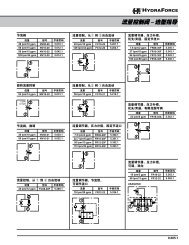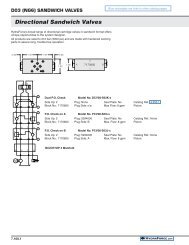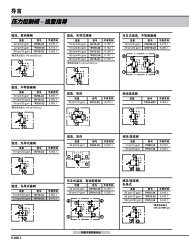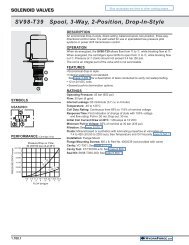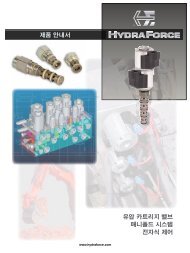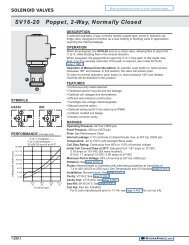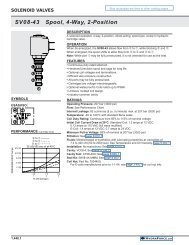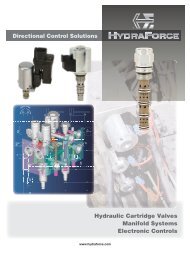Series E Environmental Coils - HydraForce
Series E Environmental Coils - HydraForce
Series E Environmental Coils - HydraForce
Create successful ePaper yourself
Turn your PDF publications into a flip-book with our unique Google optimized e-Paper software.
®<br />
HYDRAFORCE<br />
<strong>Series</strong> E <strong>Environmental</strong> <strong>Coils</strong><br />
IMPROVING DURABILITY TO ASSURE LONG LIFE IN THE HARSHEST ENVIRONMENTS<br />
<strong>HydraForce</strong> has made design changes to the industry-leading<br />
environmentally-hardened <strong>Series</strong> E coils. The new design<br />
provides longer life under high-temperature conditions, as well<br />
as easier and more convenient interchange with our <strong>Series</strong> D<br />
standard-duty coils.<br />
The Story Behind the Ratings<br />
To appreciate the performance of the new <strong>Series</strong> E coils, it is<br />
helpful to have a working knowledge of the testing conducted<br />
to assure coil life in the harshest environments. Many OEMs<br />
request a coil that is IP67 or IP69 rated. These ratings do not<br />
address the issue of the effect of high temperatures on coil life<br />
and operation. Therefore they are of limited value in evaluating<br />
the suitability of a coil for use in typical mobile equipment<br />
applications.<br />
Why temperature matters: When a coil is heated, the air<br />
inside the coil expands, creating internal pressure, causing the<br />
heated air to attempt to exit the coil. If the coil is then<br />
submerged in cold water, the air within the coil cools and<br />
contracts, drawing water into the coil through any seams or<br />
voids in the coil encapsulant. Eventually the water will fi nd its<br />
way into the winding area, causing the coil winding to corrode<br />
or short-circuit, resulting in coil failure.<br />
IP ratings are international specifi cations for electrical equipment<br />
which defi ne various levels of protection against failure<br />
resulting from contamination by water or other foreign substances.<br />
The IP67 rating is based on submerging the coil in<br />
one meter of water for 30 minutes. The coil is then inspected<br />
for evidence of water infi ltration. The IP67 specifi cation loosely<br />
states that “ingress of water in quantities causing harmful effect<br />
shall not occur.” The exact meaning of the phrase “harmful<br />
effect” is not precisely defi ned, and is therefore open to some<br />
interpretation. In this test, the coil is not subjected to high temperatures,<br />
so the effects of thermal stress are not<br />
considered.<br />
The IP69 rating, which is currently only part of the DIN version<br />
of this specifi cation, fi rst requires that the coil pass the test for<br />
IP67 as described above. Beyond that, the coil and its integral<br />
electrical connector are subjected to a rigorous high-pressure<br />
water spray. The water is mixed with detergent, is held at a<br />
temperature of 80°C., and is sprayed at the coil from a distance<br />
of 100 mm (4 inches) at a pressure of 100 bar (1450 psi).<br />
Again, the specifi cation does not precisely defi ne the amount<br />
of water ingress that would be considered unacceptable.<br />
<strong>HydraForce</strong> Ratings<br />
Working with major mobile equipment OEMs, <strong>HydraForce</strong><br />
has developed even more rigorous tests that are designed to<br />
assure that our coils will perform reliably under the harshest<br />
real-world application conditions. Both our original and our<br />
new <strong>Series</strong> E coils meet or exceed the requirements of what is<br />
known as the “Thermal Shock Dunk Test.” In this test the coil<br />
is thermally “soaked” for two hours in an ambient temperature<br />
of 100°C. The coil is then immersed immediately in a 0°C saltwater<br />
bath for two hours. This procedure is repeated ten times.<br />
The coil is then inspected for water ingress. By Hydraforce’s<br />
standards, the coil is considered to have passed this test if<br />
there is NO detectable water ingress, as determined by visual<br />
inspection and a “high pot” test. This standard requires a totally<br />
sealed coil that is impervious to moisture infi ltration, even<br />
under widely varying ambient thermal conditions.<br />
The new <strong>Series</strong> E coils can now withstand at least 10<br />
cycles of the “Thermal Shock Dunk Test.”<br />
In addition to the requirements of the industry-recognized,<br />
“Thermal Shock Dunk Test,” described above, <strong>HydraForce</strong><br />
further tests these coils for durability against failure due to<br />
vibration, as well as against failure due to the application of<br />
voltage above the coil’s standard duty rating while it is simultaneously<br />
subjected to continually varying ambient temperatures.<br />
Beyond enhancing the durability of the coils, we have<br />
decreased the wattage by approximately 10%. This reduces<br />
the power consumption and also allows the operating<br />
temperature range to be extended. The new design also<br />
improves the ease and convenience of interchanging these<br />
coils with <strong>HydraForce</strong>’s <strong>Series</strong> D (standard duty) coils, the<br />
original <strong>Series</strong> E coils, as well as the older “W-style” waterproof<br />
option. The new <strong>Series</strong> E coils use the same retaining nuts as<br />
the <strong>Series</strong> D coils, simplifying interchangeability, inventory and<br />
assembly requirements and procedures.<br />
See page 3.400.17 for detailed information describing the<br />
differences between the original <strong>Series</strong> E coils and the new<br />
<strong>Series</strong> E coils, including part number cross-references for the<br />
coils, the retaining nuts, and the spacers used on the dualsolenoid<br />
valves.<br />
®<br />
HYDRAFORCE.com<br />
3.400.2



